 |
Victoria
Falls: The Smoke That Thunders
|
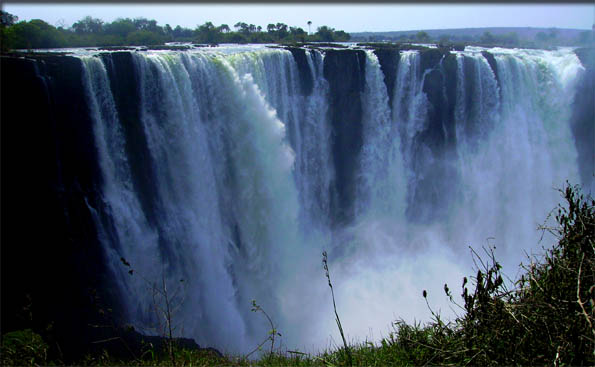
Dr.
David Livingstone had been traveling down the Zambezi River
in Southern Africa for several months. Perhaps a hundred miles
upriver during this expedition he had come to Ngonye Falls.
Livingstone had found the cataract very impressive. The falls
were only about 60 feet high but extended over the whole length
of the wide river and the amount of water that rushed over them
was staggering.
However,
on this day, November 17th, 1855, he been told he would be seeing
a spectacular cataract that would dwarf the one at Ngonye. Livingstone,
like most Europeans, had some doubts about this. After all,
at this point the river was flowing sluggishly across a flat
plateau without a mountain or valley in sight. How could you
have a big waterfall without a land feature that would cause
a sudden change in the height of the river?
As the
canoe they were paddling in headed downstream, however, Livingstone
began to hear a distant rumble. Ahead a plume of mist arose
from seemingly nowhere. By the time the canoe was pulled up
on a small island and Livingstone had walked to the edge of
the cataract, the sound had become a deafening roar.
|
Seven
Quick Facts
|
| Height:
360 feet (108m) |
| Width:
5,604 feet (1,708m) |
| Name:
Local name is Mosi-oa-Tunya which means the 'Smoke
that Thunders' |
| Discovered:
The first European to visit the falls was David Livingstone
in 1855 |
| Location:
On the border of Zambia and Zimbabwe in Southern
Africa |
| Formed
By: The Zambezi River as it removes soft sandstone
from cracks in a basalt rock plateau. |
| Other:
The mist cloud formed by the falls can be seen 30
miles (50km) away |
Below
him, the river, which was over a half mile wide, plunged 360
feet (108m) down the side of a narrow gorge which was only 80
to 240 feet (25m - 85m) wide. "Creeping with awe to the verge,"
he later related, " I peered down into a large rent which had
been made from bank to bank of the broad Zambezi…" Livingstone
had never seen anything quite like this in his entire life.
Afterward he wrote: "No one can imagine the beauty of the view
from anything witnessed in England. It had never been seen before
by European eyes; but scenes so lovely must have been gazed
upon by angels in their flight."
Livingstone,
the first European to see the mighty cataract, would name it
for his queen, Victoria. However, the name used by the African
residents of the area, Mosi-oa-Tunya, which means the
'Smoke that Thunders,' seems a much more accurate description
of this natural wonder.
Formation
of the Cataract
Victoria
Falls is the result of soft sandstone that fills huge cracks
in the hard basalt rock of the plateau. As the Upper Zambezi
flowed across the plateau in ancient times, it found the cracks
and started wearing away the softer rock, eventually creating
a series of gorges. Geologists estimate that the river has been
falling into these gorges for at least the last 100,000 years.
As the rock wears away, the cataract follows these gigantic
cracks and moves further upriver across the plateau.
|
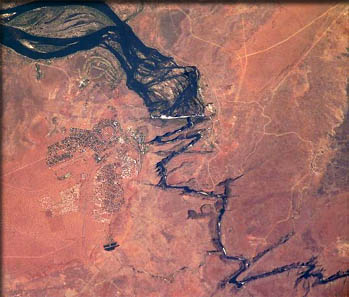
In
this picture taken from the International Space Station
it is easy to see the zigzag cracks that the river follows
after it falls into the first gorge.
|
Currently
the falls are almost a mile wide where they enter the first
gorge. From there they take a zigzag course through a series
of gorges which are designated by numbers. When the river travels
through the second gorge, it passes along a pool known as "Boiling
Pot." During high water this part of the river is filled with
heavy turbulence and whirlpools. It is often at this location
that objects, animals, and unfortunately sometimes people, are
deposited along the edge of the water after they have been unlucky
enough to have been swept over the falls.
The
river continues zigzagging through a total of six gorges, which
range from 400 to 800 feet (120-240m) deep, before settling
into a steep, walled chasm known as the Batoka Gorge which is
filled with wild rapids. After traveling 120 miles (200k) the
river finally empties into Lake Kariba. In ancient past, each
of these gorges has been the location of an earlier version
of Victoria Falls which has moved further upstream as the river
has eroded away the sandstone.
In the
rainy season from November to early April, the falls are (by
volume of water) the largest in the world only rivaled by Iguazu
Falls in South America. Victoria is higher than Iguazu by a
hundred feet, but at 5,604 feet (1,708m), it isn't nearly as
wide the South America cataract (8,858 feet/ 2,700m).
|
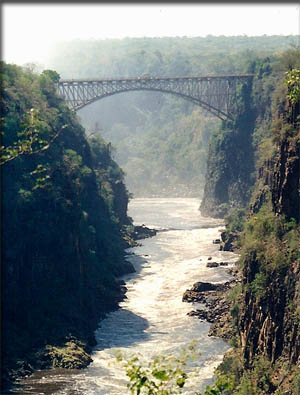
Victoria
Falls Bridge crosses the Second Gorge. (Photograph
by JackyR licensed under the Creative Commons Attribution-Share
Alike 3.0 Unported license)
|
The
character of Victoria Falls is greatly influenced by the time
of year. During the rainy season, only two islands appear at
the top of the falls. These are Livingston Island (the location
where the explorer first glimpsed the cataract), and Boaruka
Island, near the western bank. As the flow of the river drops
during the dry season many more temporary islands appear. The
change in the amount of water is so dramatic that while Victoria
has had the highest recorded peak flow, it is the third behind
Niagara Falls and Iguazu Falls in average yearly flow.
Tourism
Archeological
sites around the Falls indicate that this area has been occupied
by humans since the Middle Stone Age 50,000 years ago. To the
people that lived in the area, the Matabele, the Batswana and
the Makololo, the falls became a familiar sight, but for most
of its history was little known outside of the region. Even
after Livingstone's visit, European visitors were infrequent
due to the remote location. Then in 1905 the Victoria Falls
Bridge opened as part of an ambitious effort to build a railway
from Cape Town to Cairo. Cecil Rhodes, the English-born South
African businessman behind the project, directed engineers to
"build the bridge across the Zambezi where the trains, as they
pass, will catch the spray of the Falls". The bridge, a beautiful
steel arch, crosses 420 feet (128m) above the second gorge.
About
the same time the railway started operation, Victoria Falls
Hotel opened. Finally visitors could use the train to travel
to the site and stay in the relative comfort of the hotel. From
that point on, tourism increased (though occasionally has been
discouraged by unrest or war in the region) until at the end
of the 20th century the location was getting over 300,000 visitors
a year.
|
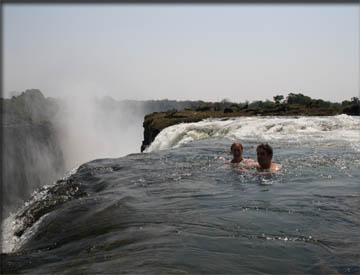
Daring
tourists can swim to the edge of the cataract at the "Devil's
Pool." (Photo by Ian Restall released
into public domain.)
|
Today,
visitors can land at the nearby airport and easily visit the
falls. The cataract straddles the boundary of Zambia and Zimbabwe,
and both countries have established national parks in here to
preserve the natural beauty and ecology of the area. In addition
to visiting the falls and the surrounding parks, the adventurous
can take a rafting ride down the rapid-filled gorges or bungee
jump from the Victoria Bridge.
One
activity at the falls which is both terrifying and exhilarating
is a swim in the "devil's pool." During the dry season the water
level drops enough that a shallow pool forms along Livingstone
Island at the edge of the falls. Normally anyone entering the
water here would be swept by the strong currents over the edge
to their death. When the levels are low, however, a natural
lip forms at the edge of the pool that keeps swimmers from being
carried over the cataract. It is possible for those bathers
with nerves of steel to lean over the slippery rock lip and
peer directly into the gorge.
The
dry season may not be just the best time to view the gorge from
devil's pool, but also from most of the surrounding area. The
heavy mist that forms while the falls are at maximum flow can
totally obscure the bottom of the gorge and make viewing from
much of the edge difficult.
However,
the mist itself can sometimes be as fascinating as the falls.
Normally it rises to over 1,300 feet (400m) and under certain
conditions it can reach double that height. The cloud it forms
can be seen sometimes as far away as 30 miles (50km). In the
bright sunlight the mist can cause multiple rainbows to appear.
Even more startling is that Victoria Falls is one of the few
places in the world where under strong moonlight you can actually
see a "moonbow" at night.
|
The
mist from the falls normally rises 1,300 feet and on nights
with a full moon can cause a "Moonbow." (Photo
by Graham Bould released into public domain).
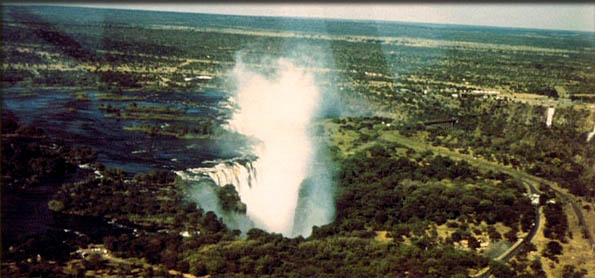
|

Copyright
2012 Lee Krystek. All Rights Reserved.